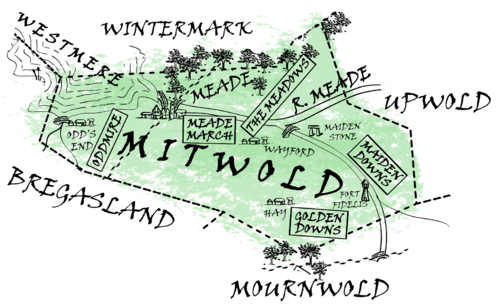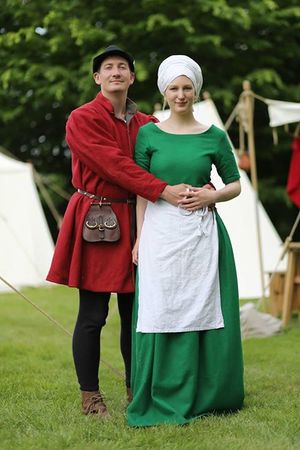Mitwold
m (→Golden Downs) |
m (→Meade) |
||
| Line 11: | Line 11: | ||
The largest settlement in the Marches is the market town of Meade in Mitwold. Crowded around the mouth of the eponymous river on the shores of Westmere, Meade is not only the spiritual and administrative heart for the nation, it’s also a port whose ships deal in fishing, trade with foreign nations and sea defence against the barbarians through Westmere and the Gullet. It’s where Marchers from smaller towns often come to spend hard-earned coin, and more often than not plays host to exotic foreigners. The Harvest’s End Festival sees Meade filled with folk from all across the Empire, and it’s said that no-one sleeps there for a week. | The largest settlement in the Marches is the market town of Meade in Mitwold. Crowded around the mouth of the eponymous river on the shores of Westmere, Meade is not only the spiritual and administrative heart for the nation, it’s also a port whose ships deal in fishing, trade with foreign nations and sea defence against the barbarians through Westmere and the Gullet. It’s where Marchers from smaller towns often come to spend hard-earned coin, and more often than not plays host to exotic foreigners. The Harvest’s End Festival sees Meade filled with folk from all across the Empire, and it’s said that no-one sleeps there for a week. | ||
In the wake of the death of [[Empress Britta]] in 376YE, semi-organised groups of bandits began to prey on traders travelling by land from Meade. By [[Town defences|order]] of the [[Imperial Senate]], in early 377YE a series of watchtowers and earthworks were constructed around Meade to help address this problem. The works were overseen by Bridget Eastville | In the wake of the death of [[Empress Britta]] in 376YE, semi-organised groups of bandits began to prey on traders travelling by land from Meade. By [[Town defences|order]] of the [[Imperial Senate]], in early 377YE a series of watchtowers and earthworks were constructed around Meade to help address this problem. The works were overseen by Bridget Eastville née Talbot (senator for Mitwold) as part of a larger plan to provide protection to towns throughout the Empire. While the defences are not sufficient to qualify Meade as a true [[fortifications|fortification]], they have already helped reduce brigandry throughout the territory. | ||
The [[Bailiff of the Grand Market]] has a small office in Meade, although most title holders spend little time there (apart from to oversee the security of the grand market on the third weekend of each month). The Bailiff is an [[Imperial title]] auctioned each Winter Solstice through the [[Imperial Bourse]] that can be held by any citizen of the Marches. | |||
=== Hay === | === Hay === | ||
“The golden fields of Hay” appear in many a Marcher song. Hay is quintessential Marches, a small rural town set amongst rolling fields. Over the last few years a number of those fields have been turned over to military camps, as the Imperial army keeps a close watch on the barbarians in the [[Mournwold|Mourn]]. A number of locals have formed themselves into the Hay Irregulars, an unofficial force dedicated to helping turn back the barbarians so that Hay’s fields can be golden once more. | “The golden fields of Hay” appear in many a Marcher song. Hay is quintessential Marches, a small rural town set amongst rolling fields. Over the last few years a number of those fields have been turned over to military camps, as the Imperial army keeps a close watch on the barbarians in the [[Mournwold|Mourn]]. A number of locals have formed themselves into the Hay Irregulars, an unofficial force dedicated to helping turn back the barbarians so that Hay’s fields can be golden once more. | ||
Revision as of 14:18, 31 January 2015
Overview - "The Pride of the Marches"
More than in Upwold or Bregasland, the households of Mitwold engage in feuding and bitter rivalry. The closer two households are to one another in Mitwold, the more likely it is that they are engaged in a bitter feud. This is also the territory where many of the best known ball games are played, and it is a regular occurence for some dispute to be settled by a savage game of rugby, football or rounders.
Mitwold's substantial coast, populated by small fishing villages along the shore, gives way to fertile chalk-soiled downs further inland, with rich game-filled woodland and larger farms and market towns beyond. There's gold in the soil of the north-western portion of the nation; the gold of summer's harvest.
Recent History
Major Features
Meade
The largest settlement in the Marches is the market town of Meade in Mitwold. Crowded around the mouth of the eponymous river on the shores of Westmere, Meade is not only the spiritual and administrative heart for the nation, it’s also a port whose ships deal in fishing, trade with foreign nations and sea defence against the barbarians through Westmere and the Gullet. It’s where Marchers from smaller towns often come to spend hard-earned coin, and more often than not plays host to exotic foreigners. The Harvest’s End Festival sees Meade filled with folk from all across the Empire, and it’s said that no-one sleeps there for a week.
In the wake of the death of Empress Britta in 376YE, semi-organised groups of bandits began to prey on traders travelling by land from Meade. By order of the Imperial Senate, in early 377YE a series of watchtowers and earthworks were constructed around Meade to help address this problem. The works were overseen by Bridget Eastville née Talbot (senator for Mitwold) as part of a larger plan to provide protection to towns throughout the Empire. While the defences are not sufficient to qualify Meade as a true fortification, they have already helped reduce brigandry throughout the territory.
The Bailiff of the Grand Market has a small office in Meade, although most title holders spend little time there (apart from to oversee the security of the grand market on the third weekend of each month). The Bailiff is an Imperial title auctioned each Winter Solstice through the Imperial Bourse that can be held by any citizen of the Marches.
Hay
“The golden fields of Hay” appear in many a Marcher song. Hay is quintessential Marches, a small rural town set amongst rolling fields. Over the last few years a number of those fields have been turned over to military camps, as the Imperial army keeps a close watch on the barbarians in the Mourn. A number of locals have formed themselves into the Hay Irregulars, an unofficial force dedicated to helping turn back the barbarians so that Hay’s fields can be golden once more.
Odd’s End
A bustling fishing port with a chip on its shoulder against the larger Meade, the fishermen of Odd’s End pride themselves on being first out to the water, the banner of Odd - a leaping salmon - raised above the waves before their Meade brethren have untied from dock. Odd was a devotee of Pride, and founded a monastery here, settling her folk on the shore when the Marchers first reached the Westmere and declaring that this would be the place where she would end her days.
Wayford
A large market town at the confluence of the upper tributaries of the Meade. A layer of gritstone in between the chalk of the wolds means the river is wide and shallow, allowing livestock from the hills to cross, or embark on riverboats to Meade itself. At the river fork in Wayford stand several gibbets with a long and bloody history, notable in recent years for playing host to Red Walder and his outlaws, a plague on the Mitwold for many years. The town is also notable due to legends that the monstrous creature known variously as Jack-in-chains, Jack-of-Irons and Bloody Jack is buried somewhere nearby.
The Maiden Stone
An ancient dolmen that stands in a scorched area of land in a grove of ash trees. Every year before the Spring festival the farmer’s wives of the area weave the largest straw dolly known in the territories. The Straw Maiden, as the creation is known, is 12 feet tall adorned with wild flowers with intricate patterns of vines woven into her skirt. The Maiden’s skirt is hollow at the base and she is placed atop the dolmen. The Landkeepers of the area then bless the Maiden in many nights of ritual. The Maiden then stands in the grove, visited by pilgrims who proffer food, trinkets and other offerings at her foot in the hope that she may bring them some small favour. This continues until the summer has ended. Mysteriously although the Maiden has been exposed to all weathers and temperaments, she does not rot, blow away or decay in any way, staying as fresh and brightly golden as the day she was placed upon the stone. Then, at the festival of Harvest there is another ceremony, the culmination of which sees the Maiden set alight, burning until there is nothing left.
Regions
Golden Downs
In 377YE the Imperial Master of Works approved the creation of Forte Fidelis in Golden downs. (OOC Note: Forte Fidelis is a rank one fortification).
Maiden Downs
Meade March
The Meadows
Oddmire
OOC Notes
- All the regions of Mitwold are under Imperial control.

